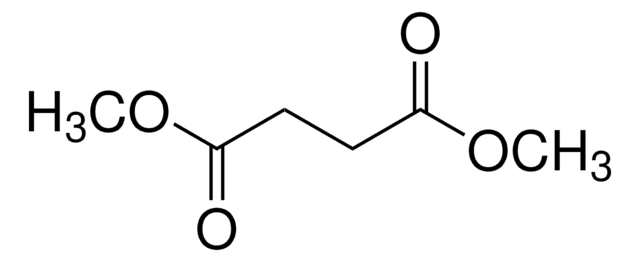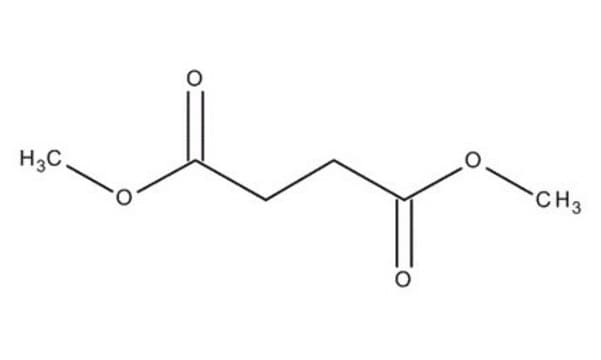S9637
Sodium succinate dibasic hexahydrate
BioReagent, suitable for cell culture, suitable for insect cell culture
동의어(들):
Butanedioic acid disodium salt, Succinic acid disodium salt
로그인조직 및 계약 가격 보기
모든 사진(3)
About This Item
Linear Formula:
NaOOCCH2CH2COONa · 6H2O
CAS Number:
Molecular Weight:
270.14
Beilstein:
3921044
EC Number:
MDL number:
UNSPSC 코드:
12352207
PubChem Substance ID:
NACRES:
NA.71
추천 제품
제품 라인
BioReagent
Quality Level
기술
cell culture | insect: suitable
cell culture | mammalian: suitable
pH
8—9.5 (25 °C, 270 g/L)
solubility
H2O: 100 mg/mL, clear, colorless
SMILES string
O.O.O.O.O.O.[Na+].[Na+].[O-]C(=O)CCC([O-])=O
InChI
1S/C4H6O4.2Na.6H2O/c5-3(6)1-2-4(7)8;;;;;;;;/h1-2H2,(H,5,6)(H,7,8);;;6*1H2/q;2*+1;;;;;;/p-2
InChI key
ZBTUYCUNQBRXOR-UHFFFAOYSA-L
유사한 제품을 찾으십니까? 방문 제품 비교 안내
일반 설명
Sodium succinate dibasic hexahydrate is the sodium salt of succinic acid, a dicarboxylic acid. This versatile compound finds extensive use in cell biology, cell culture, and biochemical research applications. It serves as both an energy source and a buffer in cell culture and cell biology research, particularly within the Tricarboxylic Acid (TCA) or Krebs cycle. It is hypothesized that Sodium succinate dibasic hexahydrate acts as an ionophore, facilitating the transport of ions across cell membranes and thus influencing cellular metabolism. Also known as Succinic acid disodium salt, this product provides the necessary substrate for ATP (adenosine triphosphate) production, essential for optimal cellular function.
애플리케이션
Sodium succinate dibasic hexahydrate has been used:
- as a supplement in the assay medium to incubate mitochondria to measure the specific activity of complex-II
- as a component in plant induction medium/ protoplast induction media (PIM) for plant regeneration
- as a small-molecule additive in the fresh medium to study its positive synergistic effects on transgene expression in Chinese hamster ovary (CHO) cells
특징 및 장점
- Versatile and adaptable for a wide variety of laboratory and research applications
- BioReagent Grade Sodium succinate for your Cell Biology and Biochemical research
- Tested for Mammalian and Insect cell culture applications
기타 정보
For additional information on our range of Biochemicals, please complete this form.
Storage Class Code
11 - Combustible Solids
WGK
WGK 1
Flash Point (°F)
Not applicable
Flash Point (°C)
Not applicable
개인 보호 장비
dust mask type N95 (US), Eyeshields, Gloves
시험 성적서(COA)
제품의 로트/배치 번호를 입력하여 시험 성적서(COA)을 검색하십시오. 로트 및 배치 번호는 제품 라벨에 있는 ‘로트’ 또는 ‘배치’라는 용어 뒤에서 찾을 수 있습니다.
이미 열람한 고객
Wei-Feng Li et al.
New biotechnology, 69, 8-17 (2022-02-27)
Chinese hamster ovary (CHO) cells are currently the most widely used host cells for production of recombinant therapeutic proteins (RTPs). Small-molecule additives related to cell cycle apoptosis and autophagy regulation have been used to promote RTP production. By combining two
Huimin Mao et al.
Stem cells international, 2020, 2016809-2016809 (2020-03-28)
Most mesenchymal stem cells reside in a niche of low oxygen tension. Iron-chelating agents such as CoCl2 and deferoxamine have been utilized to mimic hypoxia and promote cell growth. The purpose of the present study was to explore whether a
Jongjin Park et al.
Methods in molecular biology (Clifton, N.J.), 1917, 337-354 (2019-01-06)
CRISPR/Cas9 nuclease system is getting popular in precise genome editing of both eukaryotic and prokaryotic systems due to its accuracy, programmability, and relative ease of use. CRISPR/Cas systems can be delivered into live cells via plasmid DNA, RNA, and ribonucleoprotein
Georgia L Isom et al.
Cell, 181(3), 653-664 (2020-05-04)
Gram-negative bacteria are surrounded by an outer membrane composed of phospholipids and lipopolysaccharide, which acts as a barrier and contributes to antibiotic resistance. The systems that mediate phospholipid trafficking across the periplasm, such as MCE (Mammalian Cell Entry) transporters, have
Adrián Povo-Retana et al.
Cancers, 12(10) (2020-10-24)
Tumor-associated macrophages (TAMs) play a crucial role in suppressing the immunosurveillance function of the immune system that prevents tumor growth. Indeed, macrophages can also be targeted by different chemotherapeutic agents improving the action over immune checkpoints to fight cancer. Here
자사의 과학자팀은 생명 과학, 재료 과학, 화학 합성, 크로마토그래피, 분석 및 기타 많은 영역을 포함한 모든 과학 분야에 경험이 있습니다..
고객지원팀으로 연락바랍니다.












